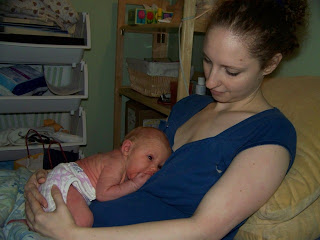Updated Tue. Mar. 24 2009 4:04 PM ET
CTV.ca News Staff
The first-ever nationwide survey of women's maternity experiences finds that while most Canadian women found their birth to be a positive experience, there were a number of areas of concern.
The Maternity Experiences Survey (MES) interviewed 6,421 women, asking them more than 300 questions about their pregnancy and birth experiences.
The survey found that the overwhelming majority of mothers -- 80 per cent -- were satisfied with their labour and birth. Fifty-four per cent said their experience was "very positive" and 26 per cent said it was "somewhat positive."
More than half (57 per cent) of women said that most days in the year before their baby was born were either "somewhat stressful" or "very stressful."
Many of the women admitted they were guilty of not following some of the recommendations of medical experts during pregnancy. For example:
- 11 per cent said they smoked during pregnancy
- 23 per cent say they lived with a smoker while pregnant
- 11 per cent said they drank alcohol during pregnancy
It was also noted that many women were not breastfeeding for the full first six months after birth. Almost 90 per cent of mothers say they started breastfeeding, and by six months, 14 per cent were still breastfeeding exclusively; another 54 per cent reported some breastfeeding.
The Canadian Paediatric Society and other groups recommend exclusive breastfeeding for the first six months of a healthy baby's life, and then breastfeeding alongside complementary foods up to two years of age and beyond.
Health care workers, too, were guilty of employing practices no longer recommended by the medical community, such as continuous use of electronic fetal monitoring during labour to check the baby's heart rate.
Research has found that continuous heart rate monitoring is related to increased use of caesarean births, forceps or vacuum. Experts recommend that continuous monitoring be reserved for higher risk labour or if there are concerns about the baby.
Despite those recommendations, nearly two-thirds of the mothers (63 per cent) reported that fetal heart monitoring was continuous during their births.
Almost half of the women interviewed (48 per cent) said they gave birth lying flat on their back, and 57 per cent of women said their legs were in stirrups when their baby was born. That's despite research that show that an upright or side-lying position can contribute to a shorter labour. They can also help mothers avoid medical interventions such as an episiotomy.
"Do women know the benefits of an upright position for labour and birth? How can women be supported to fully explore the options for labour and birth position with their health care provider?" the authors ask in a section of the study report titled "Some Things to Think About."
Other findings included:
- 97.9 per cent of births occurred in hospitals or clinics
- 26.3 per cent of women had caesarian births
- While almost 90 per cent of women took folic acid supplements during the first three months of pregnancy, only 58 per cent had taken the supplements in the three months prior to conception, the period considered crucial for preventing neural tube defects
- While almost all hospitals have policies against routine vaginal shaving or enemas in preparation for birth, 19 per cent of women said they were shaved and five per cent had an enema
The MES Survey used questionnaires to understand women's perceptions of their birth experiences. The authors note that traditional analysis using databases, national vital statistics and hospital discharge records often do not give a full picture of women's experiences.
The Study Group was particularly interested in understanding the experiences of younger mothers (15-19 years), recent immigrant mothers, and First Nations, Inuit and Métis mothers, as these women are believed to be at increased risk for adverse pregnancy outcomes.
The study authors say their survey was important because "by hearing what women say about their maternity experiences, health care providers, public health officials, policy makers and families can work toward the best possible outcomes for all mothers and babies in Canada."




























